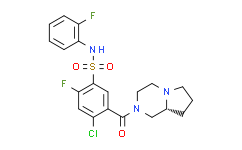| Cas No.: | 1235560-28-7 |
| Chemical Name: | Abt-639 |
| Synonyms: | ABT 639;ABT-639;0G7D0CQ88I;ABT639;(R)-4-Chloro-2-fluoro-N-(2-fluorophenyl)-5-(octahydropyrrolo[1,2-a]pyrazine-2-carbonyl)benzenesulfonamide;4-chloro-2-fluoro-N-(2-fluorophenyl)-5-[[(8aR)-hexahydropyrrolo[1,2-a]pyrazin-2(1H)-yl]carbonyl]benzenesulfonamide;5-[(8aR)-3,4,6,7,8,8a-hexahydro-1H-pyrrolo[1,2-a]pyrazine-2-carbonyl]-4-chloro-2-fluoro-N-(2-fluorophenyl)benzenesulfonamide;GTPL7721;BCP17732;BDBM |
| SMILES: | ClC1=C([H])C(=C(C([H])=C1C(N1C([H])([H])C([H])([H])N2C([H])([H])C([H])([H])C([H])([H])[C@]2([H])C1([H])[H])=O)S(N([H])C1=C([H])C([H])=C([H])C([H])=C1F)(=O)=O)F |
| Formula: | C20H20ClF2N3O3S |
| M.Wt: | 455.9059 |
| Sotrage: | 2 years -20°C Powder, 2 weeks 4°C in DMSO, 6 months -80°C in DMSO |
| Description: | ABT-639 is a novel, peripherally acting, selective T-type Ca2+ channel blocker. |
| In Vivo: | ABT-639 blocks recombinant human T-type (Cav3.2) Ca2+ channels in a voltage-dependent fashion (IC50=2 μM) and attenuates low voltage-activated (LVA) currents in rat DRG neurons (IC50=8 μM). ABT-639 is significantly less active at other Ca2+ channels (e.g. Cav1.2 and Cav2.2) (IC50>30 mM). ABT-639 has high oral bioavailability (%F=73), low protein binding (88.9%) and a low brain:plasma ratio (0.05:1) in rodents. Following oral administration ABT-639 produces dose-dependent antinociception in a rat model of knee joint pain (ED50=2 mg/kg, p.o.). ABT-639 (10-100 mg/kg, p.o.) also increases tactile allodynia thresholds in multiple models of neuropathic pain (e.g. spinal nerve ligation, CCI, and vincristine-induced, and capsaicin secondary hypersensitivity). ABT-639 does not attenuate hyperalgesia in inflammatory pain models induced by complete Freund’s adjuvant or carrageenan. At higher doses (e.g. 100-300 mg/kg) ABT-639 does not significantly alter hemodynamic or psychomotor function. The antinociceptive profile of ABT-639 provides novel insights into the role of peripheral T-type (Cav3.2) channels in chronic pain states[1]. |






















